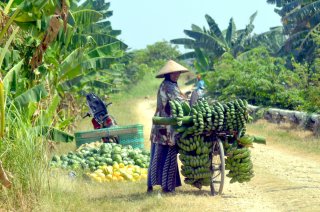
category_news
Resistance genes identified to combat Panama disease in bananas
Significant progress has been made in accelerating the development of banana varieties with resistance to the Fusarium fungus. Fusarium causes Panama disease, which destroys banana plantations around the world. Researchers at Lembaga Ilmu Pengetahuan Indonesia (LIPI) and Wageningen University & Research (WUR) have now succeeded in identifying resistance genes in bananas to tackle the notorious soil fungus. The discovery of these genes paves the way for accelerating the breeding of resistant bananas without the need for lengthy and expensive phenotyping tests.
Fusarium fungi are soilborne fungi that penetrate the roots of banana plants and then colonise and block the vascular system. This causes serious wilting and ultimately kills the plant. Fusarium wilt is commonly known as Panama disease, the most devastating disease in the banana cultivation sector. It has destroyed banana plantations all over the world. In the mid-20th century, for example, the “Gros Michel” cultivar dominated global sales before being totally decimated by what is known as the Race 1 strains of the Fusarium fungus. Banana cultivation recovered thanks to a new, resistant variety: the “Cavendish”. This is now virtually the only type of banana sold in Europe. However, while this success story is now decades old, the genetic basis for the resistance remained unknown, and Race 1 strains have now spread around the world.
TR4

Meanwhile, the Cavendish turns out to be very susceptible to a new Fusarium strain, known as Tropical Race 4 (TR4). Once contaminated, plants cannot be saved. And the fungus remains present in the soil for decades.
Towards new banana varieties
It is clear that new banana varieties have to be resistant to both Race 1 and TR4. The research carried out by LIPI and WUR is therefore focused on identifying the genes responsible for such resistance. And that research has succeeded: the genes are located on chromosome 10 of the Musa acuminata variety, an ancestor of the Cavendish banana, and those genes are now being identified in more detail. This discovery makes it possible to use “markers” (small differences in DNA made visible through the use of special technology) to accelerate the development of new banana varieties without the need for lengthy and expensive phenotyping tests.